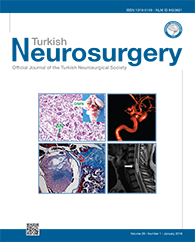2Alexandria University, Department of Neurology, Alexandria, Egypt DOI : 10.5137/1019-5149.JTN.18009-16.2 AIM: Spinal cord arteriovenous fistulas are rare cause of progressive myelopathy. The predictive factors of their outcome after endovascular or surgical treatment are still controversial.
MATERIAL and METHODS: Twenty patients were diagnosed with spinal arteriovenous fistulas; 13 of them had dural and 7 had perimedullary fistulas (1 Dorsal and 6 Ventral). Surgery, endovascular or both treatments were used.
RESULTS: Ten of the 13 patients in the dural group were surgically treated, while 2 were managed by embolization and one combined. Seven patients improved, while 6 patients showed stationary clinical course after intervention. Five patients in the perimedullary group were embolized with clinical improvement, 1 patient refused intervention, and 1 patient had surgery. Clinical improvement was significantly correlated to the duration of symptoms before intervention (p=0.012), and preoperative neurological condition (p=0.001). No significant correlation was found with age, anatomic level of the fistula, fistula type, and type of intervention.
CONCLUSION: Microsurgery was preferred for dural and dorsally located perimedullary fistula, while embolization was preferred for ventrally located ones. Clinical improvement was significantly correlated with early intervention and preoperative neurological condition of the patient. Age of the patient, fistula type, fistula location, and type of intervention did not show significant relation to the outcome. Patients could benefit from intervention even if they present with poor neurological condition.
Keywords : Spinal arteriovenous fistula, Perimedullary, Predictive factor, Embolization




